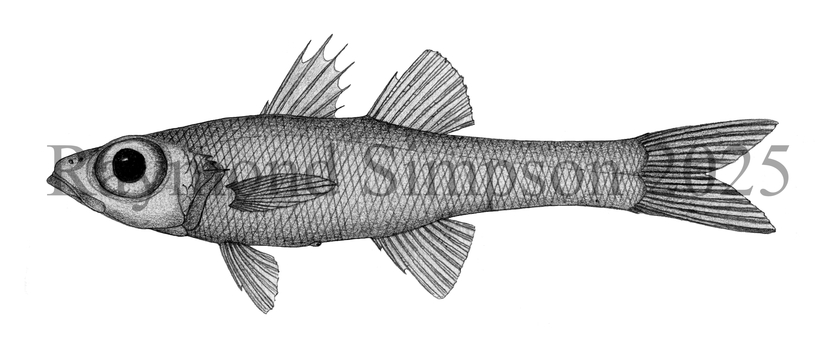
Common Name
Spinenosed Cardinalfish
Year Described
Mayer, 1974
Identification
Dorsal Fin: VII-I, 9
Anal Fin: II, 9
Pectoral Fin: 15-18
Lateral Line: 47-49
Gill Rakers: 26-30 (first arch)
Vertebrae: 10+15 = 25 total
Body slender and laterally compressed. Large terminal mouth. Teeth conical. Lingual teeth present. Vomerine teeth a compact patch. Endopterygoid teeth absent. No enlarged teeth present at lower jaw symphysis. Maxillary process pointed. Opercular spine present. Other spinelets present under main spine. Pyloric caeca 5-7. Ribs present on last abdominal vertebrae. First dorsal spine tiny. Lateral line complete and composed of pored scales. No luminous organ on belly. Gill rakers pectinate.
Color
Body dark grayish-brown on the dorsum with a silvery flank and whitish belly. Fins with dark membranes. Mouth light. Gills area variable pale to dark. Eye black.
Size
Maximum size to 120.6 mm SL.
Habitat
Occurs near hard bottoms and walls from 280-550m.
Range
New England to French Guiana, including the Caribbean Sea and Gulf of Mexico.
References
Mayer, G. F. 1974. A revision of the cardinalfish genus Epigonus (Perciformes, Apogonidae), with descriptions of two new species. Bulletin of the Museum of Comparative Zoology v. 146 (no. 3): 147-203.
Okamoto, M. 2012. Two new species of the genus Epigonus (Perciformes: Epigonidae) from the South Pacific, with a definition of the Epigonus constanciae group. Ichthyological Research, 59, 242-254.
Parin, N. V., A. M. Prokofiev, & S. Bussarawit. 2012. Two new species of the genus Epigonus (Perciformes: Epigonidae) from the Atlantic and Indian oceans. Journal of Ichthyology, 52, 239-243.
Other Notes
Epigonus occidentalis, E. pectinifer, and E. robustus are the only Epigonus in the area with strong opercular spines (the E. constanciae group). The teeth on the tongue and unique gill raker shape, among other meristic traits, separate E. pectinifer from it’s relatives.